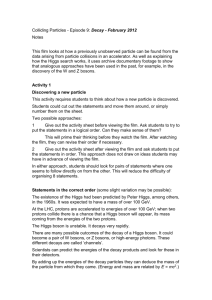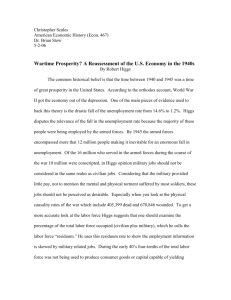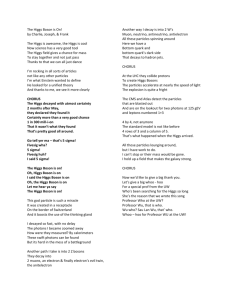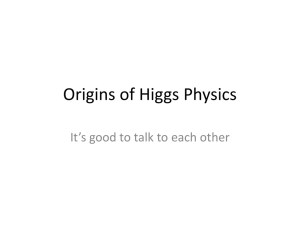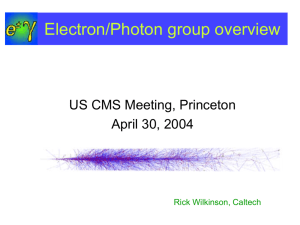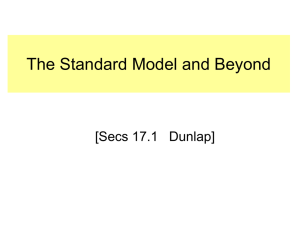triplet - University of Southampton
advertisement
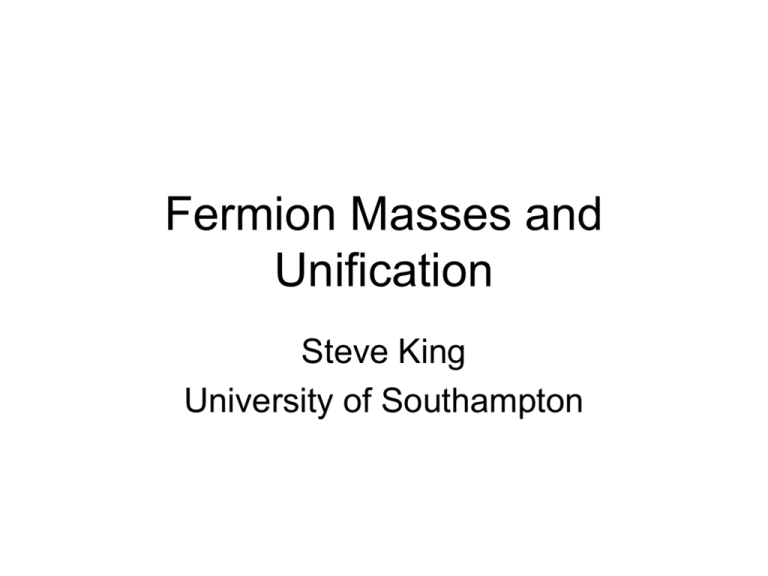
Fermion Masses and Unification Steve King University of Southampton Lecture 2 Unification Simple Group G ! SU(3) c - SU(2) L - U(1) Y Quarks and Leptons unified into representations of Most popular Groups G G are: SU(5) Quarks, Leptons SO(10) Quarks, Leptons, right-handed neutrino E6 ! 10 © 5 Quarks, Leptons, exotics, SM singlet, º R ! 16 ºR ! 27 G ! SU(3) c - SU(2) L - U(1) Y Single coupling constant g Simple Group G spontaneously broken: g ! g3 ; g2 ; gY Couplings assumed to ‘run’ to measured SM couplings Tr f T a ; T bg = N G ±ab ) If no additional (non-SM singlet) fermions are added: r g3 = g2 = g1 Applies to all three examples At GUT energy. g1 ´ SU(5); SO(10); E6 5 gY 3 GUTs E6 SU (5) U (1) SO (10) SU (4) PS SU (2) L SU (2) R SU (3)C SU (3) L SU (3) R SU (5) SU (3)C SU (2) L SU (2) R U (1) B L SU (3)C SU (2) L U (1)Y SU(5) GUT Georgi and Glashow With the hypercharge embedding Each family fits nicely into the SU(5) multiplets N.B in minimal SU(5) neutrino masses are zero. Right-handed neutrinos may be added to give neutrino masses but they are not predicted. Gauge Sector of SU(5) Summary of Matter and Gauge Sector of SU(5) Higgs Sector of SU(5) Candidate Higgs reps of SU(5) are contained in matter bilinears constructed from 5* and 10 Minimal suitable Higgs reps for fermion masses consist of 5H + 5*H The smallest Higgs rep which contains a singlet under the SM subgroup is the 24 Higgs rep and is a candidate to break SU(5) The Higgs superpotential involving the minimal Higgs sector of SU(5) consisting of the 24H plus 5H plus 5H* With some tuning (see later) one can achieve light Higgs doublets which can develop weak scale vevs The Yukawa superpotential for one family with Higgs H=5, H*=5* good bad c.f. good SUSY relations at MGUT: mb¼ m , ms ¼ m/3 , md ¼ 3me Pati-Salam Partial Unification SU (3)C SU (2) L U (1)Y SU (4) PS SU (2) L SU (2) R The Yukawa superpotential for one family a W F F h x x a Qh2u c Qh1d c Lh1ec Lh2 c u d e at the GUT scale Could work for the third family, but certainly not for all three families Y Y Y Yij u ij d ij e ij Y Y d ij e ij at the GUT scale is bad at the GUT scale is almost good Georgi-Jarlskog Textures 0 12 Y d 21 22 0 0 0 12 0 0 , Y e 21 322 0 1 0 0 0 1 Gives good SUSY relations at MGUT: mb¼ m , ms ¼ m/3 , md ¼ 3me W 12 F1 a F2 x hax 21F2 a F1 x hax a a 33 F3 F h 22 F2 F2 x x a x 3 x a (15, 2, 2) x a 1 1 V15 1 3 Gives GJ factor of -3 for the lepton Summary of Pati-Salam -- Predicts RH neutrinos with lepton number as the “fourth colour” u (4, 2,1) d u u d d e L u (4,1, 2) d u u d d e R -- Allows the possibility of restoring parity if LR symmetry is imposed -- (Quark-lepton) unification of 16 family into two LR symmetric reps -- B-L as a gauge symmetry -- Quantization of electric charge Qe= -Qp -- Pati-Salam can be unified into SO(10) (4, 2,1) (4,1, 2) 16 SO(10) GUT Georgi; Fritzsch and Minkowski The 16 of SO(10) contains a single quark and lepton family and also predicts a single right-handed neutrino per family. The SU(5) reps are unified into SO(10): The two Higgs doublets are contained in a 10 of SO(10) Neutrino masses in SO(10) 16.16.10H H0 e L R mLR L R H Dirac mass 16.16.126 H 126 H R R Heavy Majorana mass 16.16. 16H 16H 16H 2 R R M M SO(10) contains all the ingredients for the see-saw mechanism and tends to predict a hierarchical pattern of neutrino masses p 0e 5.0 1033 y ( SK ) Like ‘matter’ particles, Higgs must be embedded into representations of ! Leads to new (triplet) particles D. e.g. SU(5) SO(10) All give new particles: D ´ (3; 1) , ¡ Problems: 1 3 G hu 5H D E6 ; D ´ (3; 1) 31 (£ 3 i n E 6) 1 Spoil Unification of MSSM gauge couplings 2 Cause rapid proton decay Say hu ; hd ; D; D ! H representation of G e:g: 10 f or SO(10) And quarks and leptons ! F representation of G e:g: 16 f or SO(10) To produce SM Yukawa terms one generally uses Gives following SM interactions: FFH terms uc hu Q; dc hd Q; ec hd L But also gives ‘dangerous’ terms involving D; D with SM particles: DQQ; Ddc uc; ec Duc; QLD Proton decay c c c c D DQQ; Dd u ; e Du ; QLD D-exchange generates superfield operators In terms of scalar and fermion components some examples of dangerous operators are shown below D 1 MD D u u u u K p D K p ( p K ) c2 loop RG matrix element p K 1.6 1033 y ( SK ) 1 MD Minimal SU(5) is ruled out by proton decay -- but it gives unacceptable fermion masses anyway Two possible types of solutions: a Give large GUT scale masses to ! b D; D Doublet-Triplet splitting Allow TeV scale masses to D; D but suppress interactions ! Yukawa suppression is required a ‘Solves’ Proton Decay and Unification problems b ‘Solves’ Proton Decay problem but leaves Unification problem Nontrivial to give huge masses to D; D but not hu ; hd e.g. most simple mass term would be ! M GU T 55 in SU(5) M GU T hu hd + M GU T DD Minimal superpotential contains: SU(5) ! SM ) 2 Superpotential: D D (¹ + ¸ m) + hu hd (¹ ¡ ¸ m) 3 GUT Fine tuning to within 1 part in 1014 EW scale ‘Missing – partner’ mechanism’ e:g: mi ni mal SU(5) Pair up H with a G representation that contains (colour) triplets but not (weak) doublets (at least after G is broken). Take superpotential to contain: Under SU(5) ! 5 50 < 75 > + 5 50 < 75 > SM : 50 contains (3,1) but not (1,2) And < 75 > in (1; 1) 0 direction gives mass couplings to ) Nothing for Higgs hu , hd Problems: D; D to couple to Large rank representations problem for Higgs mass Proton decay via triplet Higgsino from effective term. •The problem (light Higgs mass) is intimately related to the doublet-triplet splitting problem (heavy triplet mass) •One approach is to allow both light Higgs doublets and triplets •Requirements: generate TeV scale mass terms for the light Higgs doublets and triplets, suppress proton decay due to triplet exchange while allowing triplets to decay in less that 0.1 s to avoid problems with nucleosynthesis •The Exceptional Supersymmetric Standard Model (ESSM) is an example of a model with extra low energy exotic matter forming complete 27’s of E6 plus the two Higgs doublets of the MSSM: [5*+10+ (5+5*)+1+1]xthree families +(H,H’) Quarks, Triplets,Higgs, leptons singlets 27 Non-Higgs ESSM= MSSM+3(5+5*)+Singlets E 6 SO (10) U (1) Right handed neutrinos are neutral under: MString MGUT Right handed neutrino masses TeV MW SO (10) SU (5) U (1) U (1) N E8 £ E8 ! E6 E6 ! SU(5)£U(1)N Quarks, leptons 15 4 U (1) 14 U (1) ! SM £ U(1)N 27', 27 ' Triplets Singlets H’,H’-bar Incomplete and Higgs and RH s multiplets (required for unification) U(1)N broken, Z’ and triplets get mass, term generated SU(2)L£ U(1)Y broken Family Universal Anomaly Free Charges: Most general E6 allowed couplings from 273: FCNC’s due to extra Higgs Allows p and D,D* decay Rapid proton decay + FCNCs extra symmetry required: •Introduce a Z2 under which third family Higgs and singlet are even all else odd forbids W1 and W2 and only allows Yukawa couplings involving third family Higgs and singlet •Forbids proton decay and FCNCs, but also forbids D,D* decay so Z2 must be broken! •Yukawa couplings g<10-8 will suppress p decay sufficiently •Yukawa couplings g>10-12 will allow D,D* decay with lifetime <0.1 s (nucleosynthesis) This works because D decay amplitude involves single g while p decay involves two g’s Unification in the MSSM 2 loop, 3(MZ)=0.118 3 2 1 MSUSY=250 GeV Blow-up of GUT region Unification with MSSM+3(5+5*) 2 loop, 3(MZ)=0.118 3 2 1 250 GeV 1.5 TeV Blow-up of GUT region MESSM= 3x27’s (no H,H’) E 6 SO (10) U (1) SO (10) SU (4)PS SU (2)L SU (2)R MPlanck MGUT E6! SU(4)PS£ SU(2)L £ SU(2)R £ U(1) SU(4)PS£ SU(2)L £ SU(2)R £ U(1) ! SM £ U(1)X (4,2,1) (4,1,2)(6,1,1) (1, 2, 2) (1,1,1) 27 x three families Right handed neutrino masses TeV MW Quarks, leptons Triplets Singlet and Higgs U(1)X broken, Z’ and triplets get mass, term generated SU(2)L£ U(1)Y broken Planck Scale Unification with 3x27’s MPlanck Low energy (below MGUT) three complete families of 27’s of E6 High energy (above MGUT» 1016 GeV) this is embedded into a left-right symmetric Pati-Salam model and additional heavy Higgs are added. MPlanck
